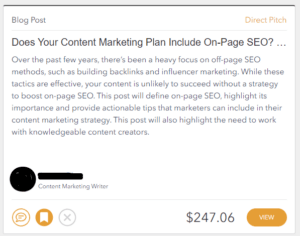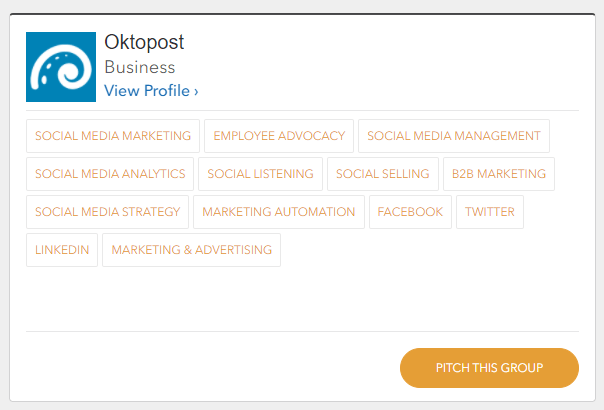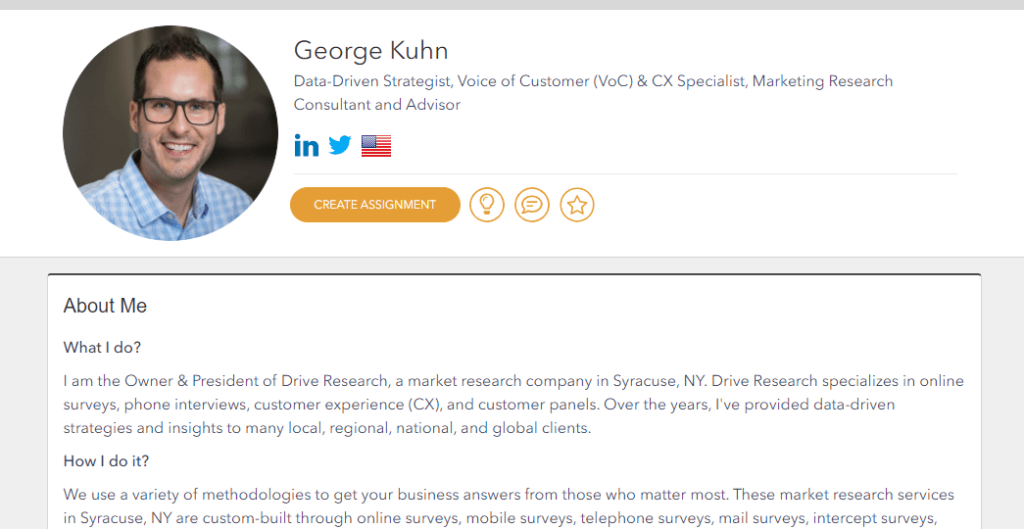In 2013, I left my full-time marketing job to become a freelance writer, despite not having any active or prospective clients. A year later, I had a small staff of 6 full-time writers creating content for more than 40 brands worldwide. How did I manage to grow a copywriting business so quickly? The answer: pitching content ideas.
Instead of cold calls and traditional sales tactics, I pitched personalized content ideas to a targeted list of prospects. After finding companies that I was uniquely qualified to write for, I piqued their interest in my services by offering a glimpse of the type of content that I (and then later, my team) could deliver to them. In doing so, I discovered that a lack of ideas was the biggest obstacle to consistent publishing, and I had found a way to alleviate that pain point. To be honest, it worked even better than I had expected.
As you might have guessed, it was this tactic that led to the creation of the nDash platform, of which you’re now a member (if you haven’t signed up, click here). Today, it’s my mission as an entrepreneur to make you just as successful in finding high-paying freelance writing clients by pitching content ideas.
What Can You Expect From This Guide?
And with that, we get to the crux of the following guide, which is intended to provide you with:
- A high-level explanation of the concept of pitching
- A practical overview on crafting and formatting a pitch
- Advice on how to generate ideas that brands are willing to pay for
- 10 tips for pitching on the nDash platform specifically
Freelance writing is one of the world’s most competitive trades, but it’s also among the most lucrative. If six-figure earnings are a goal of yours, then it’s imperative to separate yourself from the crowd. Mastering the art of pitching content ideas is a great place to start.
Once again, thanks so much for joining the nDash community. I’m looking forward to seeing your talents shine and your content ideas put into action.
Sincerely,
Michael Brown
CEO & Founder of nDash
*******
Pitching Content Ideas 101: A Conceptual Overview
Think of the last great movie trailer you watched. It was almost impossible to not then see the full film, right? In less than a minute, that video grabbed your attention, appealed to your interests, evoked an emotional response, and gave you just enough to leave you wanting more. The same response occurs when a brand receives a great content idea. But instead of paying to see a movie, they’ll pay you to write the full piece. More on this in a minute.
So, at a very high level, think of content pitches like movie trailers. They’re not the full deliverable, just a teaser of what’s to come. They are also not a generic advertisement or sales pitch but rather a promotion for a specific deliverable. Simply put, they are content ideas sent to brands for consideration.
What Does a Pitch Look Like?
While every pitch will be unique in its content, it should adhere to a standardized format. For the sake of this guide, here’s the format used on nDash:
- Title: to grab their attention
- Abstract: to preview the subject matter
- Date: to show them how soon it can be done
- Price: to show them how much it’ll cost
- Note: to include a personalized message
Here’s an example of a pitch I once sent to a marketing agency that sells to small businesses:
Title: Enterprise Marketing Tactics That Any Small Businesses Can Adopt
Abstract: Retargeting, lead generation, page 1 rankings on Google. These are just a few of the marketing practices (and results) that many small business owners consider to be out of reach. Due a perceived lack of budget and resources, they ignore these tactics and rely solely on word-of-mouth marketing. Big mistake. This post would aim to convince small business owners that they too can adopt marketing practices once thought to be “enterprise only.”
Date: 10-day turnaround
Price: $450.00
Note: Would love to hop on a call with your customer success manager to discuss alternate angles for this piece. Hope to hear from you soon. Thanks!
We’ll cover more specific examples later in the guide, but for now, this should suffice to demonstrate the simplistic nature of the pitch itself.

Who is a Pitch Sent To?
Generally speaking, pitches are sent to the person (or people) responsible for managing their company’s content marketing operation. Before the nDash platform existed, this required a lot of tedious background research, and there was no guarantee that those ideas were even going to the right people. But today, these interested parties are signing up to nDash precisely because they want to receive unique content ideas. They typically include people like:
- VPs of Marketing and CMOs
- Content marketing managers
- Small business owners
- Agency owners
- Agency account managers
- Solo consultants
In nDash, each group or brand has at least one person on the receiving end of the pitch. However, the average number of users per group is between four and five, meaning that when you send a pitch in nDash, it’s going to multiple interested parties, thereby increasing your chances of getting it accepted.
Why Does It Work?
As alluded to earlier, brands are starved for content that rises above the noise. Almost every brand wants to publish engaging blogs, articles, and other forms of content on a consistent basis. Still, a lack of original ideas—from credible writers—is stalling their efforts. That’s where you come in.
Rather than receiving a slew of spam messages (e.g., “hire me, I’m a great writer”), brands want something meaningful, insightful, and above all, actionable. Thus, the real value and potential of pitching content ideas isn’t about one idea in particular—for a writer, it’s about getting a foot in the door for a more long-term engagement. By pitching a great idea, you can showcase your expertise to a brand and get them thinking of you as a more strategic, long-term contributor.
Now that we have the basics covered, it’s time to dive deeper into the specifics of pitching on the nDash platform. Let’s get started.
Pitching on nDash: 10 Tips for Success
At the time this post was published, nearly 55% of all paid assignments in the nDash platform started as a writer pitch. This fact underscores just how receptive brands are to new content ideas, but it also illustrates how important pitching is to your success in landing paid assignments on nDash. With that in mind, here are ten essential tips for pitching on nDash, in no particular order:
Tip #1: Do NOT Pitch Generic Services
The absolute worst way to utilize this feature is by pitching generic services as opposed to original content ideas. An example of a services pitch would look something like the following:
Title: Exceptional Copywriter at Your Service!
Abstract: I’m a copywriter with more than 10 years of professional experience. I can help your brand produce a steady stream of blog post and articles on topics of your choosing.
Date: 10-day turnaround
Price: $150.00
Note:
Apart from being a violation of the nDash Writer Code of Conduct, pitches like this provide the brand with no value and are always interpreted as a salesy spam message that was likely copy-pasted to hundreds of other brands. You can tell a lot about a writer based on the quality of their ideas, and those sent in this fashion signal to the brand that the writer has not done their homework and brings little to the table.
Tip #2: Pitching Content Ideas Involves Showcasing Your Expertise
A huge reason why brands come to nDash is to find writers who have specific subject matter expertise. And upon receiving a pitch, it’s relatively easy for them to determine if the writer knows what they’re talking about. To increase your odds of success, it helps if your pitches demonstrate a deep understanding of a particular topic or industry.
Example:
Title: How to Secure a Multi-Tenant Environment
Abstract: If you offer cloud services to your customers, or if you’re using a private cloud with applications that can only be accessed by privileged users, it’s important to be able to share software and infrastructure without sharing the wrong data. This article will discuss some of the ways that enterprises must segment their databases and virtual machines, plus apply VMI in order to satisfy security and governance requirements in the cloud.
Date: 5-day turnaround
Price: $350.00
In just a few short sentences, this writer manages to convince the recipient that they know the space and can write an insightful article that will appeal to their technical audience. The bottom line here is this: pitches that convey expertise are always more likely to be accepted.
Tip #3: Acknowledge Their Brand
Before nDash existed, when I used to pitch clients by manual means, I always made it a point to acknowledge their brand in the pitch itself. This reinforced to the recipient that the pitch was personalized for them and that I did my homework before hitting send.
Example:
Title: Inside Scoop: nDash’s Most Successful Pitches — and How to Build on Their Success
Abstract: I’d like to write a post that highlights some nDash pitches that have been successful (can be anonymous), contrast with some that have not been successful (also anonymous, and we could even use some of mine), and offer tips on writing the type of pitch that is proving to be the most successful on nDash.
Date: 5-day turnaround
Price: $175.00
If you’re curious, this pitch was accepted by our team, and you can read it here.

Tip #4: Pitching Content Ideas Involves Acknowledging Their Audience
Apart from referencing the brand, it’s equally advantageous to mention their audience where appropriate. Since the brand’s goals are to educate, inform and entertain a specific target group, any ideas that clearly state the intended audience are much more like to be considered for acceptance.
Example:
Title: Understanding Why Cryptocurrencies Matter To The Marketing Profession
Abstract: While the soaring valuations for Bitcoin and other cryptocurrencies dominate the news, other features will matter more in the long term. Business decision makers need to know what’s significant about Bitcoin, Hyperledger.org, and Ethereum. This post will cover the use of Bitcoin as an alternative currency. The piece will conclude with a discussion of the potential benefits to marketing and the industries that agencies serve.
Here, the writer couldn’t be more clear about who this article would target, and it gives the brand plenty of information to decide whether this would be something of interest to their audience.
Tip #5: Read Their Brand Profile (Carefully)
To increase your odds of pitching success, it’s imperative to first read the brand’s profile page in nDash. This is where they’ll give you a high-level overview of their company and content operation, but it’s also where they’ll explicitly state the types of content and ideas they are looking for.
Apart from that specific field, you can use their profile to get a good sense of what they’ve published recently (from their RSS feed), the audience they are trying to attract, their prioritized list of keywords, and other useful information. If your pitches fail to reflect an understanding of their goals and objectives, then the odds of getting the pitch accepted drop significantly.
Tip #6: Scan for Source Material
Aside from expertise and creativity, another quality of a great pitch is timeliness—and for that, you need to be able to leverage third-party sources effectively. This can include things like:
- The news: A quick Google News search of your client’s keywords will instantly show you what’s happening in the world. If your client likes timely connections to current events, this is a great source to find fodder for an idea.
- Other blogs: Looking at other industry blogs gives you a good sense of what other companies are covering and what professionals in this space find important and interesting.
- Social media: The best place to get snippets of fast facts is social media. From a Tweet to an Instagram post to a Facebook page to a LinkedIn blog, these platforms are a collection of thought leadership, up-to-date trends, and fun interactions between people and brands.
-
- Quora, in particular, is a great resource for ideas. Searching for your client’s areas of expertise will lead you to interesting questions that may or may not have an answer, which might make a great pitch. You can also suggest to your client that you will compose an answer to post on their behalf to get them active on this site.
- Media consumption: Listening to podcasts, reading books, watching TV, or consuming media in any form broadens your awareness of the world. Whether what you are consuming has anything to do with the industry you are writing about or not, you might find inspiration in the most unlikely places.
The list of possible idea sources is almost endless, but all will suffice for crafting pitches that are timely, relevant, and give the brand a sense of urgency.
Tip #7: Enhance Existing Offers
Ironically, most pieces of branded content are not being actively marketed. They are written, published, and promoted in a relatively short time period, after which they start to collect dust. Thus, a great way to add value to a brand (and get your pitch accepted) is by sending ideas that extend the lifespan of its key assets (e.g., whitepapers, case studies).
For example, imagine that a cybersecurity brand has an old whitepaper titled “5 Ways to Mitigate Insider Threats.” As a writer, you could send them a pitch that expands on a certain section of that piece, with a CTA to download the full whitepaper. In this sense, they’ll come to view your pitch as a way to repurpose and recoup a previous content investment.
Tip #8: Have Your Profile Ready When Pitching Content Ideas
Sometimes the content of the pitch itself isn’t the only determining factor regarding its acceptance. Often, a brand will receive the pitch and then immediately go to view the writer’s nDash profile in search of additional proof points. This is why you want your profile to include things like:
- A detailed bio
- Writing samples
- Industries and keywords
- Rates and content types
- Previous work experience
A pitch might be spot-on in terms of subject matter, tone and scope, but if it’s coming from a mystery writer, then the odds of acceptance drop considerably. In this sense, it’s important to ensure that your profile isn’t working against you.

Tip #9: Never Pitch the Same Idea to Multiple Brands
Another thing to avoid right out of the gate is the urge to send the same idea to multiple brands. It can seem like a time-saver, but brands expect that all direct pitches are sent to them (and them only), and if they get a sense that that isn’t the case, it’ll likely ruin your ability to get anything accepted with them; and let’s not forget this is against the nDash Writer Code of Conduct.
But this doesn’t mean multiple brands can’t see a single pitch. For that, you can leverage the industry pitch functionality. By sending an “Industry Pitch,” your idea displays to all brands in the nDash platform and is highlighted for those that match the industry.
Tip #10: Don’t Price Yourself Too Low When Pitching Content Ideas
There is no shortage of freelance marketplaces, most designed for brands seeking the cheapest labor. With an average assignment price of $185.00 (as of January 2018), nDash is a bit different in that regard, as brands come to us to find the best writers in a given industry—not the cheapest. Thus, when a brand receives a pitch that seems too low (think $20-$40 range), it signals to them that the writer won’t take it seriously and that the quality is likely to be suspect.
In short, don’t expect an uptick in pitch acceptance by lowering your prices. Stick to the rates you’ve established with clients on the nDash platform. Don’t sell yourself short.
Conclusion & Next Steps for Pitching Content Ideas
We hope this guide has provided you with the foundational knowledge you need to excel at content pitching. That said, we realize you might still have questions about the finer details. If that’s the case, please visit the nDash Writer Help Topics.
Thanks for reading!
